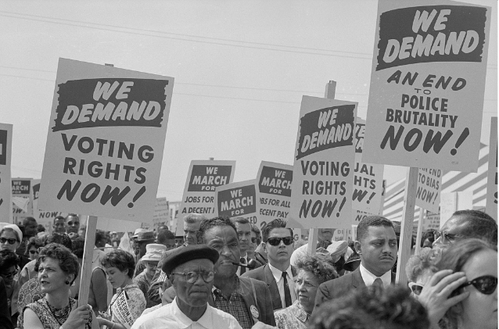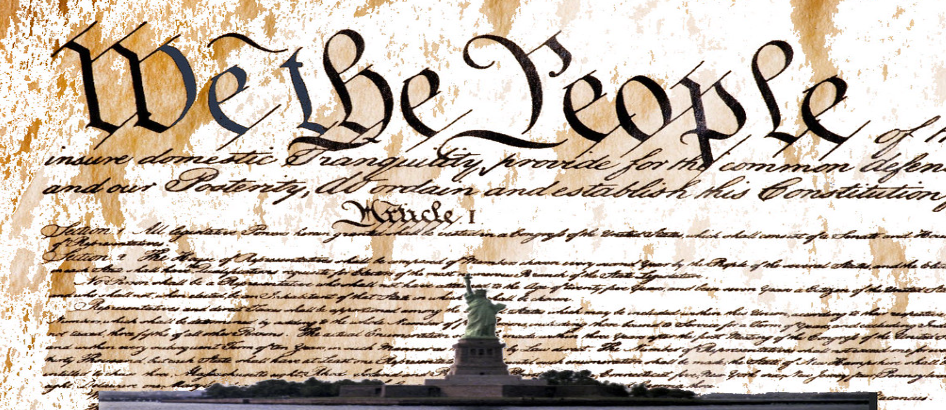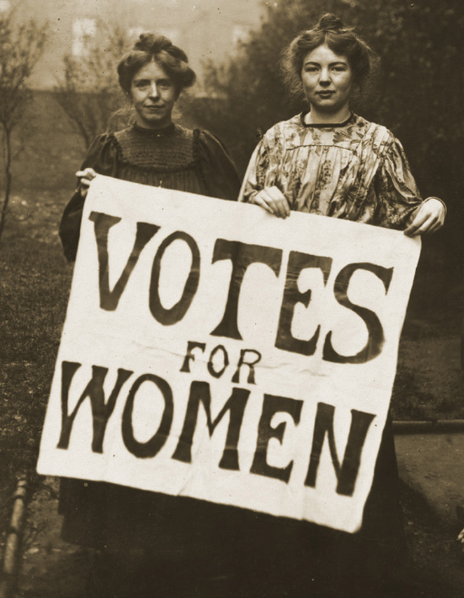A Complete History of Americans Right to Vote Part One
By: Elizabeth A. Hays
Since the Civil Rights Act of 1964, millions of Americans have exercised their right to vote every four years to elect the President and Vice President of the United States. Gaining that right for some people has not been an easy journey. Over time, American citizens have used that privilege to advance their society with the government's help.
1776 - The Declaration of Independence
In 1776, the United States of America declared its independence from Britain. The Declaration of Independence, signed by the original 13 colonies, agreed that "Governments are instituted among Men, deriving their just Powers from the Consent of the Governed," meaning that the citizens of America would ultimately decide how they were run.
In 1776, the United States of America declared its independence from Britain. The Declaration of Independence, signed by the original 13 colonies, agreed that "Governments are instituted among Men, deriving their just Powers from the Consent of the Governed," meaning that the citizens of America would ultimately decide how they were run.
1787-1788 - The United States Constitution
On September 17, 1787, the United States Constitution was created and ratified on June 21, 1788. The document’s authors created the current governmental system. Articles I, II, and III establish the three branches of the government: legislative, executive, and judicial. The Electoral College was also founded by Article II. Article IV is the first mention of the states being given jurisdiction, defining their rights to create and enforce their own laws while respecting those of the neighboring states. The amendment and ratification processes are described in Articles V and VII.
1789-1791 - Bill of Rights
After a few months of enforcing the Articles of the Constitution, the First Congress created the Bill of Rights by ratifying 10 Amendments. The primary objective was to ensure “We the People” protection from a corrupt government. During this time, "We the People" only referred to property-owning White males over the age of 21, and states determined the number of assets required to vote or run for office. Surprisingly, New Jersey made an exception for women who met the state’s property and residency requirements, allowing them to vote until the Constitution was re-ratified in 1807. These amendments carefully outlined the federal rights of “We the People.” The 10th Amendment reaffirms state authority, stating that any power not given to the federal government by the Constitution belongs to the states.
On September 17, 1787, the United States Constitution was created and ratified on June 21, 1788. The document’s authors created the current governmental system. Articles I, II, and III establish the three branches of the government: legislative, executive, and judicial. The Electoral College was also founded by Article II. Article IV is the first mention of the states being given jurisdiction, defining their rights to create and enforce their own laws while respecting those of the neighboring states. The amendment and ratification processes are described in Articles V and VII.
1789-1791 - Bill of Rights
After a few months of enforcing the Articles of the Constitution, the First Congress created the Bill of Rights by ratifying 10 Amendments. The primary objective was to ensure “We the People” protection from a corrupt government. During this time, "We the People" only referred to property-owning White males over the age of 21, and states determined the number of assets required to vote or run for office. Surprisingly, New Jersey made an exception for women who met the state’s property and residency requirements, allowing them to vote until the Constitution was re-ratified in 1807. These amendments carefully outlined the federal rights of “We the People.” The 10th Amendment reaffirms state authority, stating that any power not given to the federal government by the Constitution belongs to the states.
1803 - Marbury v. Madison
The concept of judicial review was defined by the U.S. Supreme Court case of William Marbury v. James Madison. For the first time, the Supreme Court ruled an act of Congress unconstitutional. Thus, establishing their role in interpreting the Constitution and the capability to change or repeal laws.
1803-1804 - Amendment XII
Following the resolution of Electoral College issues in the 1800 election, Congress passed the 12th Amendment in 1803, it was ratified by the states the following year. The purpose was to ratify the Constitution's Article II, Section 1, Clause 3. Previously, the first runner-up in a presidential election would become the vice president. This ratification declared that the two positions received separate votes.
1840 - States Begin to Loosen Property Requirements
By 1840, Americans were experiencing an economic depression. The states began to relax property requirements for White males to rally voters.
1857 - Dred Scott v. Sanford
In 1857, Dred Scott and his wife Harriet sued for their freedom due to gaining residence in a free territory. Their case was taken to the Supreme Court, where the final decision ruled that enslaved people were property. They were not considered U.S. citizens and were denied governmental protection or voting rights. The 13th and 14th Amendments would later overturn this decision.
1861-1865 - American Civil War
1865 - Amendment XIII
The Civil War eventually provided Congress with enough momentum to abolish slavery in the United States. Legislatures passed the 13th Amendment in January 1865 and approved it the following December, making the change official.
1866-1868 - Amendment XIV
Another election was held in 1866, through Civil War Reconstruction this time. Mass confusion erupted because of the Dred Scott v. Sandford decision denying enslaved individuals’ citizenship and the 13th Amendment eliminating slavery in the United States. In 1866, Congress passed the 14th Amendment and affirmed it in 1868. The 14th Amendment established that “All persons born . . . are citizens of the United States and of the State wherein they reside,” and that the government cannot deny to any person within its jurisdiction the equal protection of the laws.
1869-1870 - Amendment XV
The 15th Amendment quickly followed the ratification of the previous amendment. Passed in 1869 and authorized in 1870, the 15th Amendment granted all male citizens the right to vote, regardless of race. “The right of citizens of the United States to vote shall not be denied or abridged by the United States or by any state on account of race, color, or previous condition of servitude.”
1874 - Minor v. Happersett
Another landmark Supreme Court case involved Virginia Minor, an officer of the National Woman Suffrage Association, who sued Reese Happersett, the St. Louis voting registrar. Minor argued for American women that if the 14th Amendment’s equal protection clause applies to everyone, including children, then it must also apply to women. If “all persons born” means that all children born in the U.S. are citizens, then the phrase must include females. Unfortunately, the case was dismissed by the Supreme Court, which ruled that Congress only intended the 14th Amendment to apply to Black males.
1890-1910 - Amendment XIV Supreme Court Cases
Since the 14th Amendment was established in 1868, corporations have spent decades attempting to use it to include corporations in people’s rights. More than 300 cases regarding that amendment were brought to the Supreme Court from 1890 to 1910. Only 19 of them were considered to be African Americans. The other 288 were corporations trying to get the same rights as "the people," which is called "corporate personhood."
1896 - Plessy v. Ferguson
The case of Homer A. Plessy against Judge John H. Ferguson reached the Supreme Court. Officers arrested Plessy after he refused to move to a segregated railway car. He sued, arguing the arrest was unconstitutional. In the end, the Supreme Court ruled that states can enact segregation laws that remain constitutional if they “provide equal but separate accommodations for the White and Colored races.” This ruling would eventually set the precedent for “Jim Crow” laws.
1912-1913 - Amendment XVII
Passed in 1912 and certified in 1913, the 17th Amendment gave “We the People” the right to elect their state senators to represent them in the United States Senate.
The concept of judicial review was defined by the U.S. Supreme Court case of William Marbury v. James Madison. For the first time, the Supreme Court ruled an act of Congress unconstitutional. Thus, establishing their role in interpreting the Constitution and the capability to change or repeal laws.
1803-1804 - Amendment XII
Following the resolution of Electoral College issues in the 1800 election, Congress passed the 12th Amendment in 1803, it was ratified by the states the following year. The purpose was to ratify the Constitution's Article II, Section 1, Clause 3. Previously, the first runner-up in a presidential election would become the vice president. This ratification declared that the two positions received separate votes.
1840 - States Begin to Loosen Property Requirements
By 1840, Americans were experiencing an economic depression. The states began to relax property requirements for White males to rally voters.
1857 - Dred Scott v. Sanford
In 1857, Dred Scott and his wife Harriet sued for their freedom due to gaining residence in a free territory. Their case was taken to the Supreme Court, where the final decision ruled that enslaved people were property. They were not considered U.S. citizens and were denied governmental protection or voting rights. The 13th and 14th Amendments would later overturn this decision.
1861-1865 - American Civil War
1865 - Amendment XIII
The Civil War eventually provided Congress with enough momentum to abolish slavery in the United States. Legislatures passed the 13th Amendment in January 1865 and approved it the following December, making the change official.
1866-1868 - Amendment XIV
Another election was held in 1866, through Civil War Reconstruction this time. Mass confusion erupted because of the Dred Scott v. Sandford decision denying enslaved individuals’ citizenship and the 13th Amendment eliminating slavery in the United States. In 1866, Congress passed the 14th Amendment and affirmed it in 1868. The 14th Amendment established that “All persons born . . . are citizens of the United States and of the State wherein they reside,” and that the government cannot deny to any person within its jurisdiction the equal protection of the laws.
1869-1870 - Amendment XV
The 15th Amendment quickly followed the ratification of the previous amendment. Passed in 1869 and authorized in 1870, the 15th Amendment granted all male citizens the right to vote, regardless of race. “The right of citizens of the United States to vote shall not be denied or abridged by the United States or by any state on account of race, color, or previous condition of servitude.”
1874 - Minor v. Happersett
Another landmark Supreme Court case involved Virginia Minor, an officer of the National Woman Suffrage Association, who sued Reese Happersett, the St. Louis voting registrar. Minor argued for American women that if the 14th Amendment’s equal protection clause applies to everyone, including children, then it must also apply to women. If “all persons born” means that all children born in the U.S. are citizens, then the phrase must include females. Unfortunately, the case was dismissed by the Supreme Court, which ruled that Congress only intended the 14th Amendment to apply to Black males.
1890-1910 - Amendment XIV Supreme Court Cases
Since the 14th Amendment was established in 1868, corporations have spent decades attempting to use it to include corporations in people’s rights. More than 300 cases regarding that amendment were brought to the Supreme Court from 1890 to 1910. Only 19 of them were considered to be African Americans. The other 288 were corporations trying to get the same rights as "the people," which is called "corporate personhood."
1896 - Plessy v. Ferguson
The case of Homer A. Plessy against Judge John H. Ferguson reached the Supreme Court. Officers arrested Plessy after he refused to move to a segregated railway car. He sued, arguing the arrest was unconstitutional. In the end, the Supreme Court ruled that states can enact segregation laws that remain constitutional if they “provide equal but separate accommodations for the White and Colored races.” This ruling would eventually set the precedent for “Jim Crow” laws.
1912-1913 - Amendment XVII
Passed in 1912 and certified in 1913, the 17th Amendment gave “We the People” the right to elect their state senators to represent them in the United States Senate.
|
1914-1918 - World War I
The United States entered World War I in 1917 under the leadership of President Woodrow Wilson. 1919-1920 - Amendment XIX After years of fighting and vocal demonstrations from suffragettes, Congress passed the 19th Amendment in 1919 and approved it in 1920. This finally gave women the right to vote, stating that “the right of citizens of the United States to vote shall not be denied or abridged by the United States or by any State on account of sex.” 1924 - Indian Citizenship Act In 1924, Congress passed the Indian Citizenship Act, which granted citizenship to the nation’s Native Americans and protected them under the Constitution’s 15th Amendment. Unfortunately, some states continue to forcefully discourage Native Americans from voting. |
1939-1945 - World War II
Following the attack on Pearl Harbor, President Franklin D. Roosevelt (FDR) led the United States into World War II. President Harry Truman continued to lead the country to the end of the war.
1943 - Chinese Exclusion Repeal Act or Magnuson Act
The Chinese Exclusion Act of 1882 prevented Chinese immigration for 10 years, except for merchants, teachers, students, travelers, and diplomats. That quickly changed during World War II, when the U.S. allied with China against Japan. When the Chinese Exclusion Act was overturned in 1943, Chinese immigrants and Asian American children born before that time were given citizenship and the right to vote.
1947-1951 - Amendment XXII
The 22nd Amendment established presidential terms. It was passed in 1947 and formalized in 1951. This was done as a result of President Roosevelt’s being elected to four consecutive terms during World War II. Citizens who opposed FDR’s views argued America’s revolutionaries wanted to eliminate long-reigning leaders. In agreement, the 22nd Amendment states that “No person shall be elected to the office of the President more than twice.”
1960-1961 - Amendment XXIII
Until this point, the citizens of the District of Columbia (Washington, D.C.) in the United States Capitol had no right to vote for the president. In 1960, Congress passed Amendment 23 and validated it in 1961. It gave Washington, D.C. citizens the right to vote for their president.
1955-1975 - Vietnam War
United States troops entered Vietnam in 1965 under the command of President Lyndon B. Johnson. Men over the age of 18 were drafted and served in the Vietnam War.
1962-1964 - 24th Amendment
By the early 1960s, White citizens had taken the “Jim Crow” laws resulting from the Plessy v. Ferguson Supreme Court ruling to their logical conclusion. Eliminating the right to vote by creating unaffordable poll taxes for Black Americans was just the beginning of the fear and oppression these rules generated. After a long battle and extensive protest, Congress passed the 24th Amendment in 1962 and recognized it in 1964. It restored the right to vote to Black citizens, stating that they would not be denied the right to vote in any election if they did not pay a poll tax or any other tax.
Following the attack on Pearl Harbor, President Franklin D. Roosevelt (FDR) led the United States into World War II. President Harry Truman continued to lead the country to the end of the war.
1943 - Chinese Exclusion Repeal Act or Magnuson Act
The Chinese Exclusion Act of 1882 prevented Chinese immigration for 10 years, except for merchants, teachers, students, travelers, and diplomats. That quickly changed during World War II, when the U.S. allied with China against Japan. When the Chinese Exclusion Act was overturned in 1943, Chinese immigrants and Asian American children born before that time were given citizenship and the right to vote.
1947-1951 - Amendment XXII
The 22nd Amendment established presidential terms. It was passed in 1947 and formalized in 1951. This was done as a result of President Roosevelt’s being elected to four consecutive terms during World War II. Citizens who opposed FDR’s views argued America’s revolutionaries wanted to eliminate long-reigning leaders. In agreement, the 22nd Amendment states that “No person shall be elected to the office of the President more than twice.”
1960-1961 - Amendment XXIII
Until this point, the citizens of the District of Columbia (Washington, D.C.) in the United States Capitol had no right to vote for the president. In 1960, Congress passed Amendment 23 and validated it in 1961. It gave Washington, D.C. citizens the right to vote for their president.
1955-1975 - Vietnam War
United States troops entered Vietnam in 1965 under the command of President Lyndon B. Johnson. Men over the age of 18 were drafted and served in the Vietnam War.
1962-1964 - 24th Amendment
By the early 1960s, White citizens had taken the “Jim Crow” laws resulting from the Plessy v. Ferguson Supreme Court ruling to their logical conclusion. Eliminating the right to vote by creating unaffordable poll taxes for Black Americans was just the beginning of the fear and oppression these rules generated. After a long battle and extensive protest, Congress passed the 24th Amendment in 1962 and recognized it in 1964. It restored the right to vote to Black citizens, stating that they would not be denied the right to vote in any election if they did not pay a poll tax or any other tax.

1964 - Civil Rights Act
President John F. Kennedy proposed the Civil Rights Act to Congress in 1963, urging the nation to make changes to ensure the equal protection of every American citizen, regardless of race. The Civil Rights Act was eventually passed in 1964, a year later, under President Lyndon B. Johnson. It outlawed discrimination regarding employment while also integrating schools, libraries, and other public environments.
President John F. Kennedy proposed the Civil Rights Act to Congress in 1963, urging the nation to make changes to ensure the equal protection of every American citizen, regardless of race. The Civil Rights Act was eventually passed in 1964, a year later, under President Lyndon B. Johnson. It outlawed discrimination regarding employment while also integrating schools, libraries, and other public environments.
If you want to learn more about the Civil Rights Movement, check out our Voting Rights Race. At your own pace, you will discover more about the history of the march from Selma to Montgomery and the right to vote. There will be historical facts and media content about America’s voting rights history presented along the way. Once finished, you will receive a medal for your hard work!
Join the Run On History team today and discover our other races!
Disclaimer regarding articles that discuss race/ethnicity:
At Run on History, we strive to promote equality and make sure that all of our articles that cover sensitive topics are covered in the most respectful way possible.
While we aim to treat these topics with utmost mindfulness, we understand that best practices for referring to racial categories are debated. For both clarity and consistency, we have chosen to capitalize terms like “Black” and “White” when used as racial descriptors.
Join the Run On History team today and discover our other races!
Disclaimer regarding articles that discuss race/ethnicity:
At Run on History, we strive to promote equality and make sure that all of our articles that cover sensitive topics are covered in the most respectful way possible.
While we aim to treat these topics with utmost mindfulness, we understand that best practices for referring to racial categories are debated. For both clarity and consistency, we have chosen to capitalize terms like “Black” and “White” when used as racial descriptors.
Trivia Facts
- The United States Constitution begins with “We the people,” but at the time it only referred to White males over 21 who owned land.
- It was not until the Civil Rights Act of 1964 that American citizens gained equal protection for all, regardless of their race.
- U.S. Presidents are only allowed to serve two terms, and did not become federal law until after President Roosevelt was elected for four terms during World War II.



